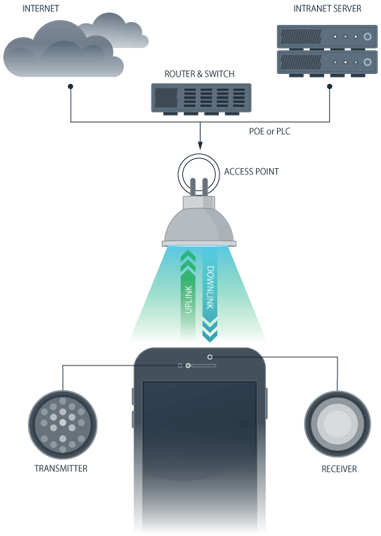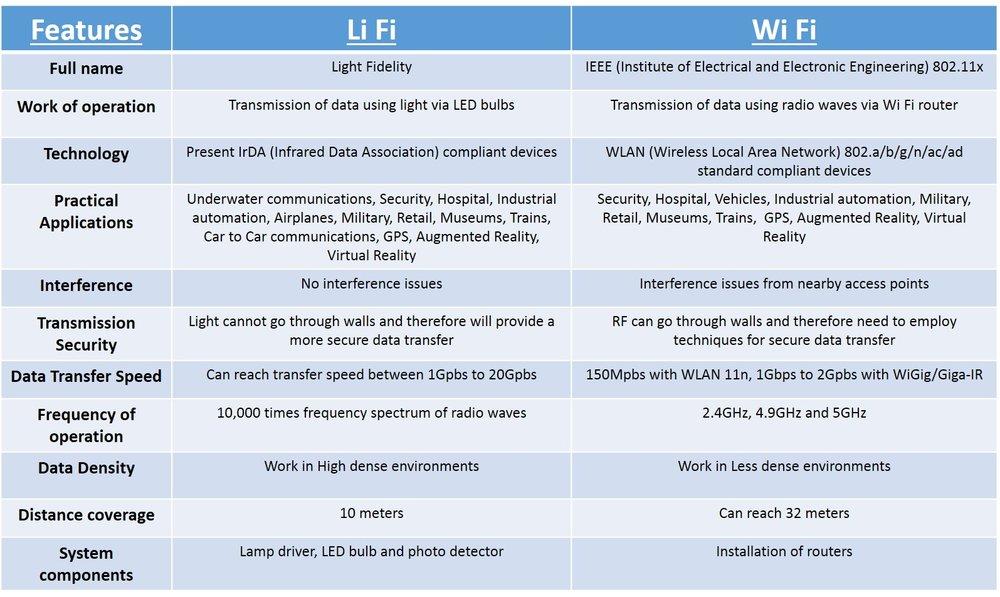What Is Li-Fi Technology: The Internet Through Lights
LiFi technology lets us connect to the internet via lamps, streetlights, or LED TVs. It's cheaper, safer, and faster than wifi and requires no router. You can surf the web on your phone or tablet by pointing it at a light bulb.
Wi-Fi today is more than 3,000 times faster than its first version, which debuted in the 1990s. Wi-Fi technology, which was made more popular by the advent of faster broadband internet connections, is still the simplest technique to enable many computers to share a broadband connection simultaneously. On the other hand, it’s possible that won’t remain the case for much longer!
Even, Wi-Fi has a lot of benefits, like being easy to set up, portable, and cheap, but it also has a lot of problems, like security, range, reliability, and speed, that are starting to bother its users. Spectrum will become a real problem as the world moves closer to the Internet of Things and more devices connect to the internet. Wi-Fi should be replaced by a different technology that doesn’t have any of these problems and also doesn’t run out of spectrum.
But what if there was a way to connect to the internet and benefit from a much faster direct connection? Li-Fi…
Yes, you read it correct! It’s Li-Fi Technology.
Li-Fi (light fidelity), a relatively new technology, is steadily gaining ground in the realm of internet technology. This technology possesses unrivalled speed and a plethora of features that have begun to awe the industry’s most influential figures in technology.
Let’s find out how this technology operates, what advantages it has over Wi-Fi, and how it will affect our life in the future.
What exactly is the Li-Fi Technology?
The transmission of a signal via Li-Fi involves modulating a lifi beam of light that travels across open space. It is possible to compare it to Wi-Fi, however the frequency band it operates in is significantly higher (430 – 770 THz vs. 2.4 GHz). In point of fact, we have been employing this very fundamental idea for more than a century, albeit in the form of Morse code being communicated from ship to ship by means of signal lamps.
With the help of the Shannon–Hartley theorem, we are able to determine the maximum bitrate that a communications channel can support given a particular bandwidth. Due to the fact that capacity grows with bandwidth, it is easy to understand the enormous potential of Li-Fi internet, which has approximately 340 THz to work with within the visible light frequency range. When you compare this to Wi-Fi, which has less than 1 GHz available yet is still able to give over a gigabit per second, you can begin to understand the possibilities for really high-speed networks in the home. When virtual and augmented reality reach the point where they are used by the majority of people, speeds of this magnitude will be required.
To give you an idea of just how much of a difference this increase in bandwidth is, consider the fact that it is nearly equivalent to the difference in mass that exists between the Earth and the Sun!
How LiFi Works?
LiFi speed is a very high in the comparison with wifi, it’s two-way, and fully networked wireless way to send and receive data using light. LiFi is a wireless network made up of several light bulbs.

When electricity flows through an LED light bulb, it sends out a stream of light particles called photons. LED bulbs are made of semiconductors, which means that the light that flows through them can have its brightness changed very quickly. This means that the light can be changed at different speeds to send the signal. The signal can then be picked up by a detector, which uses the changes in light intensity (the signal) to figure out what kind of data it is. Also, you send a digital 1 when the LED is on and a digital 0 when it is off.
People can’t see the intensity change, so communication is just as smooth as with other radio systems. Users can connect anywhere there is LiFi-enabled light. Using this method, data can be sent quickly from and back to an LED light bulb.
Li-Fi vs. Wi-Fi
The difference between LiFi and WiFi is that LiFi utilizes light for data transmission whereas WiFi makes use of electromagnetic waves at radio frequencies. Light is utilized in more dense surroundings as compared to radio frequency waves since it causes less interference than the latter and hence can be utilized.
LiFi can reach a distance of approximately 10 meters, whereas WiFi can reach approximately 30 meters.

What are the advantages of the Li-Fi
Professor Harald Haas of Edinburgh University is credited with the invention of the Li-Fi technology over ten years ago. Its data spectrum for visible light is 1,000 times greater than the RF spectrum, which means that there is more capacity to drive larger bandwidths and faster data speeds. This is one of its primary advantages and one of the reasons why it is so advantageous. The creators of LiFi internet have already proven rates of 224Gbps in laboratory conditions, and they anticipate that 1Gbps or higher – which is around 100 times quicker than standard Wi-Fi – will become the norm in the near future. While radio waves go through walls and can be intercepted, a beam of light is contained within a certain area, therefore the chance of interference is much reduced, and the system’s level of security is significantly increased.
The people responsible for developing this technology have already come up with a number of different possible applications that could be beneficial to using it. These include the provision of residential “hotspots” in high-bandwidth areas such as living rooms and bedrooms, as well as the application of the technology in intelligent workplace environments.
Pure Li-Fi co-founder and CTO Mostafa Afgani explained:
“Where we can really bring a benefit is in the crowded radio spectrum where we see the launch of a new wireless LAN standard pretty much every year but fail to deliver those data rates in practice because there’s just so much RF noise and interference out there… By offering to shift that communication to a different band – the light band – we can now provide another wireless channel that can deliver those data rates over a medium that is much more reliable and can actually deliver the quoted data rates.”
Disadvantages of Li-Fi Technology
Because Li-Fi signals are unable to travel through walls, it will be necessary to install competent LED bulbs all over the home in order to take advantage of the technology’s full potential. Not to mention the fact that in order to provide connectivity, Li-Fi demands that the light bulb be on continuously; hence, the lights will need to stay on even when the house is unoccupied. The least energy-efficient option available.
Clearly, despite all of the many benefits it offers, light-based communication cannot function without a clear line of sight between the sending and receiving devices. For this reason, the technology is seen more as a supplement to existing wireless solutions rather than a replacement for those solutions.
FAQ
Who is the founder of Li-Fi?
What are the applications of Li-Fi?
1-It is used by airlines because it won’t mess up equipment on the plane that works with radio waves, like the radar. 2-Because light can go through water, Li-Fi is used to explore the ocean floor. 3-It is used in hospital operating rooms because light waves don’t have much of an effect on medical instruments. 4-It is also used in offices and homes to send and receive data and to browse the Internet.
The Long-Term Future of Li-Fi
Li-Fi would not cost more because it can work without devices like routers, modems, signal repeaters, wave amplifiers, and antennas. At the moment, Li-Fi can’t completely replace Wi-Fi as a way to connect. But because more people want fast internet access, it is expected that Li-Fi will be available to the public by the beginning of 2022. Li-Fi may also be built into homes and buildings in the future.
Conclusion:
Because scientists and engineers all over the world are constantly and consistently conducting research into this field, it should be possible to circumvent the vast majority of these constraints.
It’s possible that LiFi will become an excellent mode of communication.
ad


Comments are closed.